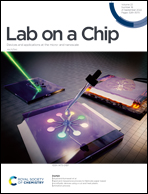Efficient bioparticle extraction using a miniaturized inertial microfluidic centrifuge†
Abstract
Conventional bioparticle extraction requires labor-intensive operation, and expensive and bulky centrifuges. Herein, we report a miniaturized centrifuge by cascading four paralleled inertial spiral channels with a two-stage serpentine channel, allowing for the efficient washing and acquisition of concentrated bioparticles from background fluids. First, the effects of channel size and flow rate on particle focusing dynamics and solution exchange performances are explored to enable the optimization and wide application of our device. Then, the integrated device is fabricated and tested experimentally. The results indicate that 10–20 μm particles can be washed from the original samples with increased concentrations and with recovery efficiencies of >93%. Finally, to verify its versatility, we use our miniaturized centrifuge to successfully change the culture medium for cultured MCF-7 breast cancer cells, extract A549 lung cancer cells from a calcein-AM staining solution, purify white blood cells (WBCs) from lysed whole blood, and extract target cells from an unbonded magnetic microbead background. Compared with conventional centrifuges, our device has the advantages of simple fabrication, easy operation, and small footprint. More importantly, it offers outstanding capability for extracting bioparticles from various background fluids, and avoids bioparticle damage that may be caused by high-speed centrifugation. Therefore, we envision that our miniaturized centrifuge could be a promising alternative to traditional centrifuges in many applications.



 Please wait while we load your content...
Please wait while we load your content...